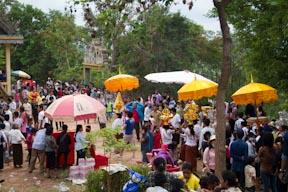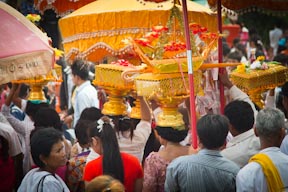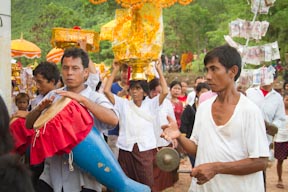Our Khmer language tutor, Khena, invited us to a Bon Katen at a Wat located a little over an hour’s motorbike ride east of Battambang.
A Bon Katen is a celebration that raises donations for the Wat, or Buddhist temple complex. As we would discover, it’s a bit more than just that.
Khena met us at our hotel at 8:00am on a Sunday morning. Sunday is the standard day off around these parts.
From the hotel, with Khena and her sister on one motorbike, and Jen and I on another, we headed east on Highway 5 for about an hour, eventually arriving at the home of one of her married sisters.
It was a typical Khmer house on the side of the highway – wooden, built on stilts, the sleeping area in the enclosed house above, the outdoor cooking and lounging area in the open spaces underneath the house. Plenty of relatives and children and dogs were about, as were a couple of turkeys.
Khena’s brother-in-law and his father are wood carvers. They make wood sculptures and furniture. We saw their outdoor work area behind the house, and some of their products. They are skilled.
The family members were great hosts. The brother-in-law cut a coconut for us to drink the milk, and we played with the children and the dogs while the family finished preparing and loading food for the celebration. Khena and a young, teenaged, male relative of hers took us to a nearby food stand to get a vegetarian lunch to go. His name is Big – that’s the English word, “Big.” It was a recognition of his large size as an infant. Of course, he’s no longer big at all.
Once everyone was ready, we headed to the Wat. Big drove a motorbike with Khena and her sister as passengers. Jen and I followed on our motorbike. The brother-in-law came next in a packed car that looked like a more-square version of the Pacer. Bringing up the rear was the brother-in-law’s father and his wife, also on a motorbike.
Most of this part of the trip was down several kilometers of wide, straight, dirt road. The closer we got to the Wat, the thicker the traffic – motorbikes, tractor-drawn carts carrying twenty or more people, bicycles, a small number of cars.
The road dust also became thicker, and Jen was seriously wishing she had brought one of the surgical masks so many people wear around here. My eyes were constantly hit with dirt particles, and I sometimes struggled to see enough of the road to swerve around potholes. At a handful of places, the roadway was under water, and we had to negotiate ponds of calf-deep mud that often exceed fifty meters in length (our prior experience driving muddy tracks in Laos came in handy).
The folks heading to the Wat were dressed up a bit – older Khmers wore skirts and dresses and slacks; many younger Khmers wore new and colorful hats; some younger girls were dressed like they were hitting the town on a Saturday night, including high-heeled sandals. The density of people on the road continued to increase, and it was obvious that this was going to be a big community event.
We transited the central crossroads of a small village just outside the Wat, parked our motorbikes and the car at the house of a relative, and walked a short distance to the temple grounds.
 The dirt streets were packed with people, and we joined a slowly moving, extremely thick column of Khmers walking toward the Wat. On the banks of this river of people were venders selling grilled meats, other snacks, and water. A group of men, playing instruments in the middle of the road, became an island around which the river continued to flow.
The dirt streets were packed with people, and we joined a slowly moving, extremely thick column of Khmers walking toward the Wat. On the banks of this river of people were venders selling grilled meats, other snacks, and water. A group of men, playing instruments in the middle of the road, became an island around which the river continued to flow.
Inside the temple grounds, it looked like an amped-up version of a county fair. There were more food stands, and ice cream stands, as well as stands selling clothing and other goods. A handful of carnival rides were operating. The noise and music were almost deafening. Literally thousands of people filled the temple grounds. From this mass, a thick stream flowed up a concrete staircase toward the pagoda on the hill. We followed this stream, ascending hundreds of steps.
Having completed the climb, sweat dripping from the heat and humidity and press of people, we joined Khena’s family on a small rise some fifty meters from the pagoda. Here, we watched people and ate lunch.
Or should I say that people watched us? Jen and I were the only foreigners present, and we attracted a great deal of attention. Groups of Khmers – young and old – would just stand and stare at us. We would smile back, which usually turned the stares into smiles or laughter. A handful of mothers tried to encourage their shy children to come over to us and say hello. We had our pictures taken by one group of young girls, and Jen took some pictures in return. A man sitting with his family kept gesturing for me to come drink beer with him.
The density of people, the significant attention we drew, the stares… It all made us a bit uncomfortable at times. It was hard to tell if we were unwanted intruders or just curiosities. Our maybe-we-shouldn’t-be-here warning lights would start to blink; but then someone would smile, or say “hello,” or tell their child to wave, and things would seem alright again.
A little after noon, a procession of mostly older Khmers came toward the pagoda. The procession was led by a handful of folks playing percussion  instruments, the most notable being a man who banged away at a cowbell-sounding thing while dancing a freestyle jig. Behind the musicians came several women with ornate costumes and golden hats; other folks carrying two-foot-tall tree ornaments, paper money hanging from their branches; and others carrying gold and yellow umbrellas.
instruments, the most notable being a man who banged away at a cowbell-sounding thing while dancing a freestyle jig. Behind the musicians came several women with ornate costumes and golden hats; other folks carrying two-foot-tall tree ornaments, paper money hanging from their branches; and others carrying gold and yellow umbrellas.
As the procession came to the pagoda, it began to move clockwise around the building. Numerous onlookers joined the procession, including Khena, Big, and us. Soon, there were hundreds of people walking around the pagoda. The sounds of the musicians merged with the loudpeaker-projected pronouncements of someone inside the pagoda. It was cacophonous. (Click the player below to hear a sound clip.)
As we walked with the procession, an older woman reached through the crowd and ran her hand up and down my arm, feeling the hair (I have some pretty thick arm hair). Khena translated what she said, which was “soft.” I guess thick male arm hair is a novelty around here.
After three times around the pagoda, the procession stopped, and we rejoined Khena’s family.
Soon, we all headed down the hill, back down the concrete staircase, following a reverse stream of people.
At the bottom of the hill, at the corner of a field, we sat with Khena and Big to watch all the activity. The carnival rides were going. An outdoor disco was in full swing, with music blaring and a dense mob of Khmers jumping up and down. Men sat at tables drinking beer and whiskey. Vendors continued to sell food and wares from carts and tarps laid on the ground.
The amount of beer and liquor being thrown into the mix caused our maybe-we-shouldn’t-be-here warning lights to start blinking again. We could smell alcohol on several passing men, and their reactions to us became more animated as time went on. Drinking at a table near us was a group in military uniforms – the authority figures in a country known for corruption. Earlier, I had seen some uniformed guys carrying loaded assault rifles like two-year-olds carry cork guns. As things happened, there were no problems. But, being the only two foreigners, standing out like sore thumbs in a crowd of thousands, many of whom are drunk men, and many of those drunk men being guys with authority, and some of those guys being armed…Well, that made our warning lights blink just a little bit brighter.
After about three hours at the Wat, we walked back to our motorbikes for the ride home…and this is where the real fun began. You see, Khmers like to throw water on each other. Water balloons, buckets and bowls of water, makeshift water guns, store-bought super-soakers…the roads leading from the Wat, in all directions, were lined with hundreds of people armed with these weapons.
As we walked through the gauntlet to the house where our motorbikes were parked, we were barraged with water balloons. One Khmer came in for some close-quarters combat, dousing Jen and I with a bucket of water. We were soaked by the time we got to the bikes.
Now we prepared ourselves and the bike to run back through the gauntlet. Jen donned a rain jacket, strapped on her helmet, and put the helmet’s visor down. It was water-combat body armor.
We raced down the road as fast as we could, weaving between pedestrians, and passing other bikes and tractor-drawn carts. Water balloons flew from both sides of the road. Bucket-full’s of water were thrown at us and those near us.
In the middle of all this, an older woman in extremely nice clothing walked alone down the middle of the road. She walked slowly, making no effort to avoid the fray. Projectiles and water flew all around her, but she was untouched.
Not so for us; or for Khena and Big and one of Khena’s sisters, who were on a motorbike in front us. We were all hit repeatedly.
From the village crossroads, a straight dirt road ran several kilometers back to the main highway to Battambang. This was the same dust-choked road we had used to get to the Wat. Along its entire length, it had also been turned into a gauntlet of water ambushes.
Every couple of hundred meters, we would hit a group of roadside water warriors. It was some of the craziest motorbike riding we had done in Southeast Asia, weaving between potholes and carts of people and other motorbikes, dodging water projectiles, and going as fast as we could.
We are quick learners. We started using tractor-drawn carts as shields; and letting other bikes lead us into an ambush, hoping they would draw all the fire and exhaust the ammunition.
We were helped a bit by being white foreigners. Not because our attackers didn’t want to douse foreigners, but because they were surprised at the sight of us. This caused a few seconds of hesitation, and that few seconds often allowed us to get far enough through the ambush that their throws went wide.
The tractor-drawn carts seemed to get the worst of it. They were slow, and their passengers were nicely packaged into large, dense, hard-to-miss targets. Jen noticed that the tractor drivers tended to slow down at ambush sites, giving the attackers ample opportunity to thoroughly soak everyone.
There were a few mobile water-warriors, throwing water balloons and firing squirt guns from motorbikes and tractor-drawn carts.
Luckily, the attackers did not – except in one case – make use of the flooded, calf-deep-mud areas in the roadway. The mud forced everyone to slow down, and a handful of water-chuckers could have murdered us at these points. At the one place that the attackers did make use of a mud obstacle – a hundred-meter-long quagmire – we minimized our personal damage by using tractor-drawn carts as shields.
Finally, after a long race through miles of water ambushes, we hit the pavement of the main highway. We were a mess. The red dust of the road had combined with the water from our hits, and we were caked in mud.
We also stank pretty good, as the water used by our attackers was drawn from ponds and drainage ditches on the sides of the road. Cows lived in and near this water. We had, quite literally, been manured.
But it had been a grand, fun time racing through the water gauntlet.
We now headed west, back to Battambang, seeing occasional wet spots on the road that were littered with little plastic bags. Water ambushes had even occurred on the main highway, all the way back to Battambang.
As we neared our hotel, we were signaled to pull over by a cop standing at the side of the road. We stopped, and he started saying something about our headlight, likely in an effort to collect a “fine.” He stopped mid-sentence when he noticed our muddy clothes, and seemed to ask what all that was about. I said the Khmer word for water, and made a throwing motion. He smiled, and motioned for us to go.







